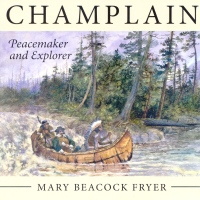| ________________
CM . . . . Volume XVIII Number 14 . . . . December 2, 2011
excerpt:
Samuel Champlain sometimes referred to as the father of Canada, was a most interesting man. (Many books on Champlain refer to him as Samuel de Champlain. Fryer preferred not to use the de.) Champlain crossed the Atlantic between France and North America 26, possibly 28 times. He did so in very small ships that took weeks to make the voyage. During his visits to New France, the term used to describe France's colonies in North America, he did his best to establish permanent settlements and befriend the natives he encountered. Champlain: Peacemaker and Explorer is a biography of this unusual man's life from his mysterious beginnings in 1570 until his death in 1635. (Champlain's parentage is not known for certain. The exact date of his birth may have been any year from 1567-1570. Fryer chose 1570.) Mary Beacock Fryer, the author of Champlain, is an experienced writer having penned a number of books on Canadian history. These include Escape: Adventure of a Loyalist Family and Bold, Brave and Born to Lead: Major General Isaac Brock and the Canadas. Champlain gives the appearance of a factual, well researched and scholarly study. It does have some features that make it worthy of recommendation. When there is any doubt about a fact, for example, alternative theories are given. Appendix B, a Chronology of important dates during Champlain's life is excellent. On the whole, however, Champlain is a frustrating and, sometimes, confusing book. Champlain lived a very exciting life. Everything he did, as recounted in this book, was never dull, from crossing the Atlantic, to founding settlements to joining native war parties to attack the Iroquois. However, the sense of excitement usually associated with the story of his life is missing in Champlain. Fryer's prose lacks the touch to make the story come alive. There are also occasional sentences that require an explanation. "The boiling rapids soon dictated the head of navigation" is one example. Assumptions that the reader will understand certain words and phrases are another problem. This is not a good idea in a book intended for younger readers. Some examples follow: arpent of land, astrolabe, Sagamore, mercenaries, and Jacques Cartier. A few footnotes, including one to identify Cartier, would have been useful. Inaccuracies and confusing statements are numerous. They seriously reduce the book's value. Christian Island in Huronia is said to be in Lake Simcoe when it is in Georgian Bay. Honfleur, a French port, is spelled Honfleur and Honfeur. The text reads: "In the two campaigns of 1609 and 1610, the Mohawk lost as many as 250 warriors." A few pages earlier it states, "Champlain thought 1,000 Mohawk warriors had been slain." Other quotes are equally puzzling. "To make up for his losses, d'Aulnay then tortured all but two of the prisoners to death" is one example. How would torturing prisoners help to make up for losses? Another example stands out like a sore thumb. "The expedition left on April 8,....dropped anchor at Tadoussac on March 26, only 18 days out from Honfleur." The errors and confusion suggest that the book was hastily produced. They might not have occurred had it been more carefully edited. Champlain has an Index, Bibliography and excellent Chapter Notes. It also has the Chronology mentioned above and a list of Champlain's publications. In addition, it contains sidebars "Fascinating Fact" and "Wordplay." The latter give explanations of important terms of relevance to Canadian history, such as the Métis. These teaching/learning aids are well done but they do not make up for the book's weaknesses. It has a few black and white illustrations at various locations and five maps. Three are reproductions of 17th century maps and of little help to today's reader. The book has 20 chapters, most of seven pages or less. Recommended with reservations. Thomas F. Chambers, a retired college teacher, lives in North Bay, ON.
To comment
on this title or this review, send mail to cm@umanitoba.ca.
Copyright © the Manitoba Library Association. Reproduction for personal
use is permitted only if this copyright notice is maintained. Any
other reproduction is prohibited without permission.
NEXT REVIEW |
TABLE OF CONTENTS FOR THIS ISSUE
- December 2, 2011.
AUTHORS |
TITLES |
MEDIA REVIEWS |
PROFILES |
BACK ISSUES |
SEARCH |
CMARCHIVE |
HOME |
